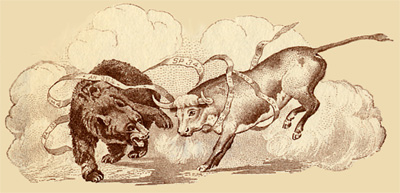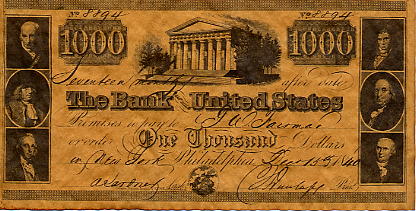FAQ
Why are the words "bull" and "bear" used to describe the financial markets?

There are many theories about how "bull" and "bear" became market terms, but the most common explanation comes from the nature of the animals. The bull tosses things up with his horns, while the bear tears fruit and honey down from trees with his claws. The bull, therefore, represents an upward moving market, and the bear represents a downward moving market.
Where did "Wall Street" get its name?
In 1653, a wall was constructed on the northern part of the Dutch settlement of New Amsterdam to protect the colony from an attack from New England. The wall was made of 16-foot logs sunk four feet into the ground and sharpened at the top. The English did attack in 1664, and the wall was torn down in 1699. The street where the wall once stood was subsequently named "Wall Street."
Do you buy or appraise old stock certificates?
From time to time the Museum purchases new objects for the permanent collection from its small collection acquisition budget. The overwhelming majority of the items in the Museum's collection were donated to help the Museum pursue its educational mission. Owners of old certificates wishing to sell them should consult a commercial appraiser to assess their value.
I found an old certificate and would like to find out if it is valuable. What should I do?
First, you will need to find out whether the security is still active or is obsolete. To do this, you can begin by either searching for the company name and/or trading symbol on a financial website or asking your broker to find out for you. If you would like to do the legwork yourself, you can call the state securities regulator's office in the state of the company's incorporation (which you'll find printed on the certificate) to find out the history of the company, including stock splits, mergers, acquisitions, etc. Or you can use the following resources -- found in most libraries -- to determine this information:
Financial Information, Inc.
30 Montgomery Street
P.O. Box 473
Jersey City, NJ 07303
Moody's Industrial Manual
Moody's OTC Industrial Manual
Moody's Investor Service, Inc.
99 Church Street
New York, NY 10007
National Stock Summary
National Quotation Bureau, Inc.
An Infobase Holdings Company
150 Commerce Road
Cedar Grove, NJ 07009-1208
OldCompany.com / Scripophily.com
Publishers of the Robert D.Fisher and Marvin Scudders Manuals of Valuable and Worthless Securities
P.O. Box 223795
Chantilly, Virginia 20153
Phone Toll Free 1-888-STOCKS6
Direct 1.703.787.3552
Fax 1.703.995.4422
Security Owner's Stock Guide
Standard & Poor's Corp.
25 Broadway
New York, NY 10004
If the stock is still paying dividends, you can call the company or your broker to determine the value of your stock. However, even if the company is no longer in business and the stock is worthless, the certificate itself might have value as a collectible. Please e-mail our curator to request a list of antique securities dealers, or search online for dealers specializing in scripophily (collecting antique financial documents) to learn the value of your certificate.
I have some old documents and want them to remain in as good a condition as possible. How should I handle and care for them?
Among the media saved by museums, archives and libraries, antique paper is fairly durable. The high rag content of old paper and good quality of ink used by our forbearers helps explain why we are able to read John Hancock's signature on the Declaration of Independence over two centuries later. Enemies to long-term conservation are fire, exposure to extreme light, great fluctuation in temperature and humidity, bugs and contact with corrosive materials. Tape and glue should not be used in the vicinity of antique paper; if present they should be left in place or removed by a trained conservator. Institutions and collectors take care to store documents in acid-free sleeves, files and boxes, available from library supply companies. Curators handle antique paper documents with gloves, to avoid contact between the object and the contaminating substances found on our skin.
I own the note pictured here. Is it valuable?

Unfortunately, no. These notes, bearing the number 8894, were produced as souvenirs and sold in gift shops throughout the country.
How many companies were listed in the original Dow Jones Industrial Average (DJIA), and what were they?
The original DJIA consisted of a dozen stocks: American Cotton Oil, American Sugar, American Tobacco, Chicago Gas, Distilling & Cattle Feeding, General Electric, Laclede Gas, National Lead, North American, Tennessee Coal & Iron, US Leather (preferred), and US Rubber. Only one, General Electric, is in the average today.
Why do traders wear different colored jackets?
The jackets identify which firms the traders work for, so it is easier to tell them apart on the exchange floor.
